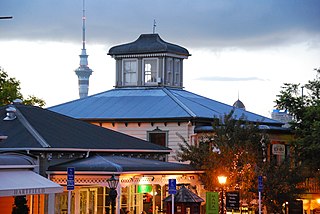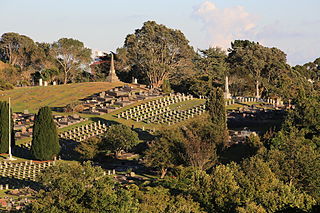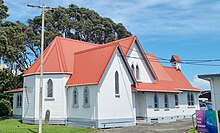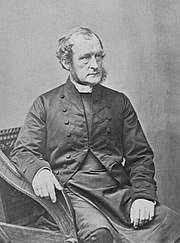The Anglican Church in Aotearoa, New Zealand and Polynesia, formerly the Church of the Province of New Zealand, is a province of the Anglican Communion serving New Zealand, Fiji, Tonga, Samoa, and the Cook Islands. Since 1992 the church has consisted of three tikanga or cultural streams: Aotearoa, New Zealand, and Polynesia. The church's constitution says that, among other things, it is required to "maintain the right of every person to choose any particular cultural expression of the faith". As a result, the church's General Synod has agreed upon the development of the three-person primacy based on this three tikanga system. It has three primates (leaders), each representing a tikanga, who share authority.

All Saints’ Church is an heritage-listed Anglican church located on the corner of Cook Street and Selwyn Road in the suburb of Howick, in Manukau City on the North Island of New Zealand. The church was the first parish church in Auckland and is the oldest building in Manukau.

Parnell is a suburb of Auckland, New Zealand. It is one of New Zealand's most affluent suburbs, consistently ranked within the top three wealthiest, and is often billed as Auckland's "oldest suburb" since it dates from the earliest days of the European settlement of Auckland in 1841. It is characterised by its mix of tree-lined streets with large estates; redeveloped industrial zones with Edwardian town houses and 1920s bay villas; and its hilly topography that allows for views of the port, the Waitematā Harbour, Rangitoto Island and the Auckland Domain. To its west lies the Auckland Domain, to the south Newmarket, and to the north the Ports of Auckland.

Holy Trinity Cathedral is an Anglican cathedral church situated in Parnell, a residential suburb of Auckland, New Zealand. It is the 'mother church' of the Anglican Diocese of Auckland and the seat of the Bishop of Auckland. The current main church building was consecrated in 1973.

Old St Paul's is a historic site, a city landmark and a wedding and event venue in the heart of Wellington, the capital city of New Zealand. The building served a dual role as the parish church of Thorndon and the pro-cathedral of the Diocese of Wellington of the Anglican Church between 1866 and 1964. It exemplifies 19th-century Gothic Revival architecture adapted to colonial conditions and materials, and stands at 34 Mulgrave Street, Pipitea, close to Parliament Buildings.

St Matthew's-in-the-City Church, sometimes abbreviated as St Matthew's, or commonly known as St Matthew-in-the-City, is an historic Anglican church located at 132-134 Hobson Street in the central business district of Auckland, in the North Island of New Zealand. Part of the Anglican Church in Aotearoa, New Zealand and Polynesia and the Diocese of Auckland, the church was completed in 1905 and is renowned for its Gothic Revival style.

Holy Trinity Church is an Anglican church in Port Chalmers, New Zealand. The church building is constructed in volcanic stone and has some fine stained glass, and is listed as a Category I Historic Place. Together with St Barnabas Church, Warrington, Holy Trinity Church is part of the Port Chalmers-Warrington Parish of the Anglican Diocese of Dunedin, New Zealand.

The Reverend Frederick Thatcher was an English and New Zealand architect and clergyman.

St Paul's Church is an historic Anglican church, located on Symonds Street near the University of Auckland and Auckland University of Technology, in the central business district of Auckland, New Zealand. The church is the longest established church building in the city and has one of the largest Anglican congregations in Australasia.

All Saints' Church is a heritage-listed Anglican church located in Dunedin, New Zealand. Established in 1865, the church is part of the Dunedin North parish in the Diocese of Dunedin.

Holy Trinity Avonside was a heritage-listed Anglican church located in Linwood, Christchurch, New Zealand. It was registered as a "Historic Place – Category I" by the New Zealand Historic Places Trust. The church building was "damaged beyond the point of repair" in the February 2011 Christchurch earthquake and was demolished the following September.

St Saviour’s at Holy Trinity is an Anglican church in Lyttelton, Christchurch, New Zealand. St Saviour's Chapel was relocated from West Lyttelton to Christchurch's Cathedral Grammar School in the 1970s. Following the earthquakes and the demolition of Holy Trinity Church, Lyttelton, St Saviour's was returned to Lyttelton to the site of Holy Trinity in 2013.

Te Henui Cemetery, also known as New Plymouth Cemetery, is the oldest public cemetery in New Plymouth, New Zealand. It was first used in 1861.

Holy Trinity Church is a heritage-listed Anglican church at 141 Brookes Street, Fortitude Valley, City of Brisbane, Queensland, Australia. It is the second church on that site. It was designed by Francis Drummond Greville Stanley built from 1876 to 1877 by James Robinson. It was modified in 1920-1921, 1925 and 1929. It was added to the Queensland Heritage Register on 21 October 1992.

The St Stephen's Chapel is a historic Anglican church in Judges Bay, Parnell, Auckland.

The Taranaki Cathedral Church of St Mary is an Anglican cathedral church, located at 37 Vivian Street, New Plymouth, in New Zealand. Following the 2011 Christchurch earthquake, in 2016 the cathedral was closed for repairs.

The Selwyn churches were a group of 19th century Anglican churches and chapels in the Auckland region, New Zealand named after Bishop Selwyn who inspired their construction. The majority were built in wood in the neo-gothic style and many were designed by the architect Frederick Thatcher.

The Gables in New Plymouth's Brooklands Park was a colonial hospital originally built in Mangorei Road, on the northern bank of the Henui Stream. It was one of the four hospitals Governor Sir George Grey commissioned in the late 1840s for European New Zealanders (Pakeha) and Maori patients in New Zealand’s North Island. Now an arts centre, the building is historically important as it reminds of the first attempt to provide quality medical care to all New Zealanders and of Governor Sir George Grey's policy of assimilation by establishing mixed hospitals. The building also has rarity value as it is the last remaining of the four original hospitals. It is architecturally important as well, being one of the earliest surviving buildings designed by an architect in New Zealand.

Te Henui Vicarage from New Plymouth, New Zealand, is one of the heritage buildings of the city, registered by Heritage New Zealand as a Category 1 Historic Place, situated in the suburb of Strandon. It features the symbol of the undivided diocese of New Zealand (1841–1856) affixed to the front elevation.
























